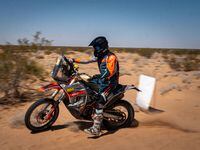In the final analysis, what we’re left with is a brand-new BMW that arrived on scene and did exactly what most people thought would be impossible—blew all the established players completely out of the water, Bismarck style, on its maiden voyage. Whatever tenths the Beemer gave up to a few of the other contestants in the corners (not many), it more than got back on Moto Aragón’s long back straight, where it blitzed the timing lights 7 mph faster than the next speediest bike; 181 mph is not hanging around.
What the BMW S 1000 RRjust pulled off here is even more of an incredible feat when you consider the bike it beat—by a wide margin if you look at just lap times—did the same thing to the Open-class competition just one short year ago: the Cycle World 2009 Ten Best Superbike winner Aprilia RSV4 Factory. BMW took aim at a moving target and blasted it right between the eyes.
At MasterBike 2008's running of the big machines, the pecking order was Honda, Kawasaki, Suzuki, Yamaha, MV Agusta. Just two years later, the four Japanese machines are bringing up the rear, beaten by a German Four, an Austrian Twin and three Italians. To look at the specs, it really wouldn't appear to be a horsepower thing (except in the case of the overdog BMW) or a weight thing holding the Japanese bikes back, but it does look like it really could be an electronics thing.
Last year, in "A Very Ambitious Machine" (CW, August, 2009), BMW's Hendrik von Kuenheim told Technical Editor Kevin Cameron, "We have seen the end of the horsepower race... the future is in drivability." Kuenheim was telling half the truth anyway: In addition to having 15 more horsepower on the European dyno than the next-closest competitor (ZX-10R), the BMW sports a second-generation traction-control system utilizing a "sensor cluster" that even factors lean angle into the power-delivery calculation. Not many MasterBike riders were really enamored with the BMW's chassis, but that didn't stop seven of 15 of them from setting their best time on it anyway (and it would've been eight, and an even bigger victory margin for the BMW, if not for Cernicky being in Sport instead of Slick mode). Apparently, the system works.
Ducati's 10-level traction-control system no doubt benefits from that company's racing experience, and the 1198S is its first appearance on a production Ducati (though the 1098R had it a year sooner): DTC, wrote our man Canet at the bike's launch (CW, March, 2009), "instilled a level of confidence that coaxed me to screw the power on aggressively enough out of second-gear corners to either push the front or have it elevate into a sweet leaned-over wheelie." That's confidence, and like Cernicky reports from this MasterBike, the new MV Agusta F4 seems to shop at the same tailor, with a Magneti Marelli eight-level TC system and twin-map ECU of its own. On the spec chart, the MV aligns in near lockstep with the Yamaha R1. On the track, the MV blows the R1's doors off by seconds, not tenths. Meanwhile, Aprilia, Suzuki and Yamaha get user-selected multi-map ECUs to change power delivery, the ZX-10R has "Kawasaki Ignition Management System" that serves as a rudimentary form of TC, and the Honda gets nada. We respect those bikes' purity; the stopwatch does not.
There it is. Looks like the Japanese have been out-electroniced by the Euros. We don't think they'll take it lying down.
































/cloudfront-us-east-1.images.arcpublishing.com/octane/MPHXIIV54NAU5L6E4SYZHCXVRM.jpg)



/cloudfront-us-east-1.images.arcpublishing.com/octane/WYXFHF4ZOBBTXELIZDB2FJXU64.jpg)
/cloudfront-us-east-1.images.arcpublishing.com/octane/K5FNV7ONUVDXJJ2H5BIWUGBGTI.jpg)
/cloudfront-us-east-1.images.arcpublishing.com/octane/MGVKP5VTNJHQ7FWNAHIWX4OHO4.jpg)
/cloudfront-us-east-1.images.arcpublishing.com/octane/6JEYTSIZQRHPJAVVPRLWZU63UM.jpg)
/cloudfront-us-east-1.images.arcpublishing.com/octane/XJU3VJZSDFEOVDBJTRXTTLTN5U.jpg)

/cloudfront-us-east-1.images.arcpublishing.com/octane/A6O3TEZF45BVFG2KKOUMPWEYM4.jpg)
/cloudfront-us-east-1.images.arcpublishing.com/octane/MHVFMH2YN5DT3EOZPLXKNFP3VM.jpg)
/cloudfront-us-east-1.images.arcpublishing.com/octane/VILA5L7CTBGOJGDKM2YAOCR6VU.jpg)
/cloudfront-us-east-1.images.arcpublishing.com/octane/GZMZRTYRS5A75G2EJDDGXLJEEE.jpg)
/cloudfront-us-east-1.images.arcpublishing.com/octane/6KWAL3TFNJBGTJMJSKQ2C6I3IY.jpg)
/cloudfront-us-east-1.images.arcpublishing.com/octane/GK5I5R3X7JCABGCKAKT4XY2K7U.jpg)


/cloudfront-us-east-1.images.arcpublishing.com/octane/RGUT3Y65IFGDFMLHQ3U7G5UUQE.jpg)

/cloudfront-us-east-1.images.arcpublishing.com/octane/37CSHD6CKRHYXHRB67EOLDS6XM.jpg)
/cloudfront-us-east-1.images.arcpublishing.com/octane/FYB7GKDGLVE3JKXMM75JTG2RYA.jpg)
/cloudfront-us-east-1.images.arcpublishing.com/octane/3ECVMM622VAZHIOLI6Q6ILWULU.jpg)
